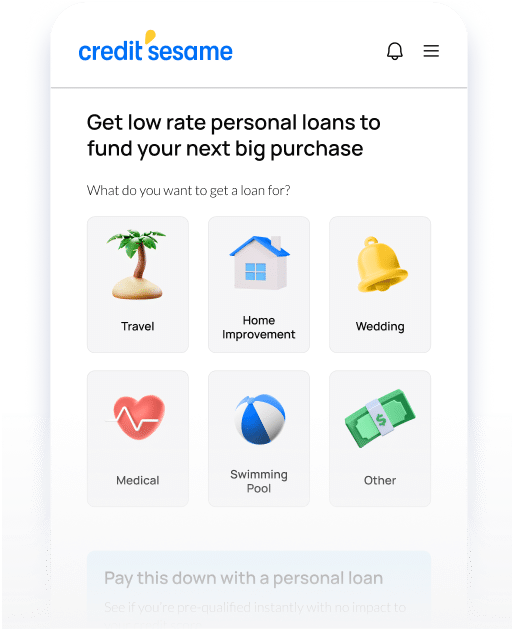How to apply for a student loan
Education offers career options, new avenues for building wealth, and opportunities to pursue meaningful work. To achieve those dreams, students often turn to loans to supplement personal savings and a part-time job to pay the cost of tuition, room, board, and other education expenses.
This page explains how borrowers can apply for a student loan. It compares these loans to other types of debt. It shares recommended steps to take when applying for a loan.

Find the right loan for you
Gain access to personalized loan recommendations based on your credit profile and approval odds. 100% free.
By clicking on the button above, you agree to the Credit Sesame Terms of Use and Privacy Policy.
What is a student loan?
A student loan is a financial product that approximately 43 million Americans actively use to fund their education. There are many types of loans, each with its own terms. Some come from the government, while others are available from private banks and lenders. Some student loans have predictable interest rates, while others are variable.
People use student loans to cover expenses at small private colleges and big public universities. They can fund education and training for virtually any career track, whether a borrower plans to become a doctor, a construction worker, or a forester.
Student loans require a commitment from the borrower. Many are designed to be paid back in 10 years, though some people take 20 years or more to pay off their student loans. Borrowers should do their research, evaluate all available funding paths, and commit to a student loan only after confirming it makes sense for their career path, budget, and money goals.
Uses of a student loan
Student loans are specifically built to help borrowers cover expenses associated with getting an education. Colleges identify a number known as the cost of attendance, which reflects the typical cost of going to the institution for a year. Borrowers can use loan funds to cover expenses up to this level. Common expenses paid for with student loans include:
- Tuition, which comprises classes and associated fees
- Books and other gear needed for studies
- Room and board, either on campus or at an off-campus apartment or house, including monthly rental costs plus utilities such as water and electricity
- Food
- Transportation expenses, such as fuel and public transit
Other expenses, such as child care and study abroad fees, might also qualify. Borrowers should learn the ins and outs of student loans that interest them to decide which best fits their situation.
How student loans compare to other debt types
Student loans are more straightforward than some types of debt because they can be used for a single purpose: education expenses. By contrast, credit cards can be used for many expenses. Borrowers seeking to strengthen their credit and boost their credit score often hold multiple debt types, including student loans and credit cards. This adds to a borrower’s credit mix and demonstrates their ability to reliably make payments over time.
Although using a student loan is straightforward, the large number of student loan vendors can be complex for borrowers to navigate. Similar to a mortgage, which helps purchase a large asset such as a house, a student loan represents an investment in another major asset—a borrower’s education and professional skill set.
It’s important to perform due diligence, read the fine print on student loan terms, and look for alternative funding paths to ensure the borrower only takes out as much debt as they need. Borrowers who take out more debt than they need might find themselves paying too much for their education. Early planning can streamline borrowers’ budgets and keep their financial aid requests focused, which can save money.
Steps to apply for a student loan
Whether borrowers are first-time college students or experienced professionals returning for an advanced degree, they can benefit from following a series of common steps. This process helps borrowers assess their financial needs, pursue student loans with terms that best suit their budget, and develop a payback plan to maximize financial freedom after graduation.
1. Calculate financial need and have a payback plan ready
Borrowers should list out all available sources of funding for their education before applying for a student loan. This could include:
- Savings held by themselves or a parent in an interest-bearing checking or savings account
- Education investments, such as a 529 or Education Savings Account (ESA)
- Gifts or contributions of money from family and friends
- Scholarships the borrower has earned or has been promised by the school of their choice
- Anticipated earnings from a side hustle, part-time job, or work-study program
It’s a good idea to do this with the borrower’s entire education in mind. For example, suppose a borrower is pursuing a four-year degree, and the anticipated all-in cost is $30,000. The borrower should think carefully about how to fund $30,000 annually for four years. This totals $120,000 in expenses.
This approach represents a good rule of thumb, though it’s imperfect. That’s because such a calculation doesn’t factor in the cost of inflation. Higher education expenses generally rise each year, often at a fast clip. Borrowers should conduct online research, use free online calculators, visit with financial aid professionals, and even talk to friends and family. Get a sense of how much money is needed to cover all anticipated expenses.
It’s often best to overestimate the funding required. If expenses are less than expected, surplus funds are always handy. If costs are more than hoped, having the funds available gives peace of mind. Borrowers who plan for the high end of expenses have a larger safety net of cash for unexpected expenses.
Once the borrower has the final anticipated cost of education on paper, they can subtract the funds they have in hand–or expect to have in the future. For example, if a student’s education costs $120,000, they can determine how much loan is needed by removing cash in hand, such as a $20,000 merit scholarship, a $5,000 work-study program, and a $10,000 grant. The borrower would subtract the $35,000 of available funds from the total cost of education. A loan of $85,000–the balance required to study for the degree–should cover most expenses.
Set aside additional savings for unexpected expenses while in school. These funds should be liquid, meaning they are available quickly as cash in a bank or a lock box in the borrower’s home or apartment. Such savings can complement a student loan and cover expenses that a student loan might not help fund.
Before starting to shop for student loans, have a plan in mind to pay back the debt. Many people take out debts and make minimum payments, limiting their spending ability for years or decades. Do the math to decide how much will be owed monthly when payments kick in. Understand how interest will compound over time. Borrowers should align this information to their anticipated monthly career earnings upon graduation. The borrower should make enough to cover the cost of student loan payments plus other living expenses, savings, and investments.
2. Evaluate federal student loan options and payment terms
Most borrowers start the student loan exploration process by filling out the Free Application for Federal Student Aid (FAFSA). This government application points borrowers to available federal loans and other programs that can fund their education. Borrowers should list their information and, if applicable, that of a cosigner such as a parent.
This document can be shared with schools the borrower is considering attending. It enables schools to review the student’s financial picture, including family income and savings, against available school funding programs. The school can then match the student to eligible funding programs. This could include federal student loans. These can take longer to process than loans from private lenders, yet they are popular because they have a capped interest rate. This is designed to make student loans more affordable for families.
In some cases, the FAFSA process might reveal that a borrower can only cover some expenses with federal loans, grants, or scholarships. If that happens, students can explore private loan options.
3. Study private student loan providers and payment terms
Banks, financial services companies, and other vendors provide private student loans. These can be approved more quickly once a borrower applies. Tradeoffs include the potential for higher, variable-rate interest on loans. Private loans can also include stricter payback terms and conditions.
Borrowers can limit their financial risk by limiting the amount of loan dollars they secure. They can pursue loans with fixed interest rates, low rates, or both. They can supplement private loan dollars with government-backed student loans and other products, such as grants and scholarships, with few strings attached.
This approach enables borrowers to fund their education and ensure a high quality of life after graduation when payments begin.
4. Determine if a co-signer is needed
Sometimes, first-time students require a co-signer to secure a student loan. Borrowers and co-signers such as parents should discuss the responsibilities they will have. If a student becomes unable to pay for a loan after graduation, the parent must take on that role. Timely payments of monthly balances can strengthen borrowers’ and co-signers’ credit. Missed payments can damage credit for anyone signed onto the student loan.
Co-signing can be beneficial because it shows lenders that students have the financial support available to successfully fund and pay back a loan.
5. Apply for one or more student loans
As with credit cards and other debt, there isn’t a limit on how many student loans a borrower can hold. Most borrowers should aim to cover education expenses without taking out funds that won’t be used. Also, keep in mind what it will be like to pay those loans off later. It’s easier to handle a single monthly payment to a trusted lender than a dozen payments, each with its own online payment portal.
Because loan application reviews take time, borrowers should calculate when they need the funds and work backward on the calendar to decide when to submit papers. Millions of students go to school each year, so avoiding the last-minute crush of applications is important to ensure borrowers get education money on time. Many borrowers apply for loans between one year and two months before the semester begins.


6. Participate in the loan origination process and sign the loan papers
Once lenders review and approve a borrower’s student loan application, there will be more paperwork and signatures. Monitor email inboxes for the next steps. Once everything is completed, lenders will get a packet of fully executed materials. Keep a digital file for your records. Print a backup copy to store for future reference.
7. Begin getting and using loan money for education
Funds for education will be deposited into the borrower’s account in the weeks after the application is approved and signed. Some borrowers get funds within about two weeks of the start of classes. Different lenders have different time windows.
Make and manage a simple budget document illustrating recurring expenses, one-time costs, and big-ticket items on the horizon. This ensures good stewardship of available funds and helps borrowers set aside dollars early without needing to dip into savings unexpectedly.
In a nutshell
Existing federal and private student loan programs make it easy for borrowers to apply for student loans. A multi-pronged approach to paying for school can help borrowers maximize loan dollars, save money over time, and prepare for financial success after graduation.
Applying for student loans resembles applying for other types of debt, with an important exception: a student loan can be obtained from the federal government, not just private lenders. Borrowers can use the free FAFSA form to assess their financial picture. They can then study the list of financial aid available to them and decide what combination of loans, grants, scholarships, investments, and savings might be best for them.

Get approved for the right loan
See loans with the highest chance of approval based on your credit profile
By clicking on the button above, you agree to the Credit Sesame Terms of Use and Privacy Policy.
Share this
More related articles

Ready to find the right loan?
See your score.
Get the right loan options.
See your score. Get the right loan options.
See cards with the highest chance of approval based on your credit profile
By clicking on the button above, you agree to the Credit Sesame Terms of Use and Privacy Policy.















